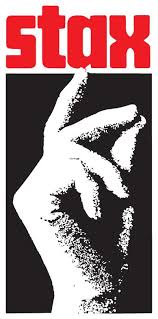As of the end of the 2019 season, Rita and I had attended games at 22 MLB stadiums (out of 30). And then Covid hit, stalling our bucket list endeavor.
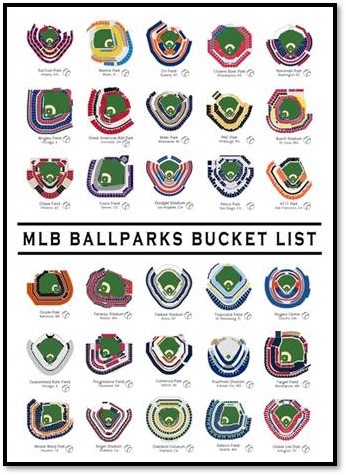
Last year, we added three stadiums to take our count to 25. This left Seattle, two in Texas and two in Florida.
And now Texas is done. From June 21 to 23, we spent a weekend in the Lone Star State to see home games of the Rangers and Astros.
Globe Life Field in Arlington, Texas: Richard Martin grew up in Dallas. He came to Kansas City in 1992 to work with our friend Woody Overton on the Clinton-Gore campaign. He never left and has now lived half his life in KC.
Richard is aware of our bucket list and suggested we join him in Dallas while he was visiting family. A bonus was that the Royals would be playing. So here we are at Globe Life Field on Friday night, June 21. And as you can see by his hat, Richard’s primary loyalty is now with the Royals (but he was ecstatic last year when the Rangers won their first World Series).
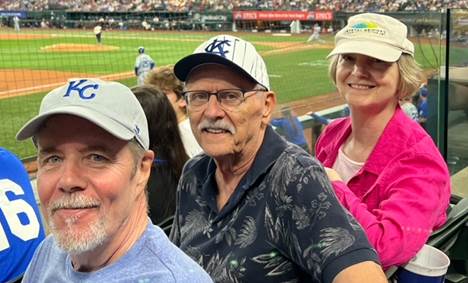
Globe Life Field is the third park for the Rangers since the former Washington Senators moved to Texas in 1972. All three parks have been in the same general area in Arlington, a midway point between Dallas and Fort Worth.
Stadium #1: The first was Arlington Stadium, a former minor league park that was expanded for the major league team and used until 1993 (22 seasons). The final game at that stadium was also the final game in the careers of two first-ballot Hall of Famers – George Brett and Nolan Ryan. This fact is noted in a timeline display at the current stadium (and in this clip showing George getting a hit in his last career at bat).
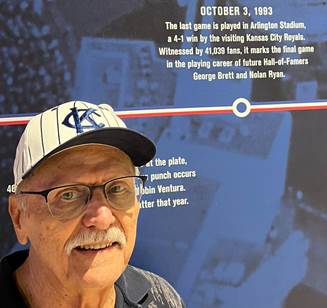
Six days before that game in Arlington, Brett played his last game at Kauffman Stadium. I was at that game with Rita and my mother to see George famously kiss home plate in his goodbye to the K.
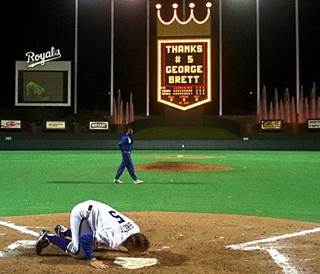
Stadium #2: The second stadium was newly constructed The Ballpark in Arlington, which was home to the Rangers from 1994 to 2019. Just 26 seasons before moving on to…
Stadium #3: Why the quick change to a new stadium? The summer heat and frequent rains. The Rangers wanted a retractable roof and air conditioning, and they got these with their third stadium, Globe Life Field, which opened in 2020 (currently the newest MLB stadium). Below, Rita during our guided tour in the afternoon before the game.

The development of Globe Life Field includes a ballpark village of restaurants, bars and stores plus two Loews hotels (Rita and I stayed at one of them). Nearby is The Ballpark in Arlington which has been renamed Choctaw Stadium and now hosts soccer, rugby and UFL games. Within easy walking distance is the Cowboys’ AT&T Stadium where COPA soccer games were being played the weekend we were there. The ballpark village was hopping with fans for all the games.
The biggest star among the many memorabilia exhibits is Nolan Ryan. He is featured outside with a statue way larger than life…
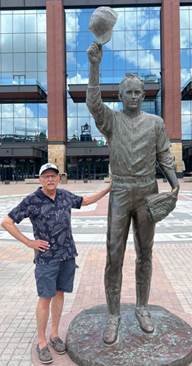
…and inside with this life-size bobblehead (it actually bobbles).
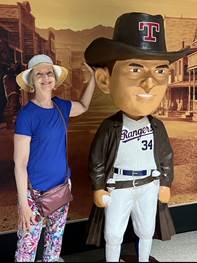
On July 16 this year, the stadium will host the MLB All-Star game.
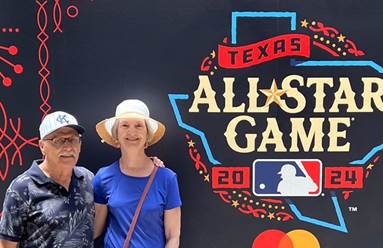
As with most stadiums, the music is pumped in so loud as to be irritating. To make the point of how loud, the scoreboard borrows the phrase “Take it to eleven” from the movie This Is Spinal Tap. In the movie, the rock band Spinal Tap changes the knobs on their amplifiers so that the highest number is 11 rather than 10. I’ve noted this in prior Hot Stoves, but I can’t resist again linking the hilarious clip from the movie. Click here.
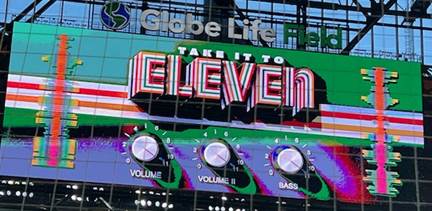
As for the game, The Rangers won 6-2.
Plaza Research: On the morning after the game, Richard drove us through the neighborhood where he grew up – the Highland Park suburb of Dallas. Highland Park is becoming a familiar name to Kansas Citians because it is the home of Highland Park Village, a Spanish style retail shopping center opened in 1931. Why? Because the owners of Highland Park Village just purchased the Country Club Plaza, a Spanish style retail shopping center opened in 1923.

Richard gave us a tour of the center, and Rita and I were impressed. It’s gorgeous. Well maintained. Visible security. Local restaurants. No vacancies. Attention to detail. Beautiful landscaping. The development timeline of Highland Park Village is a good read (click here).
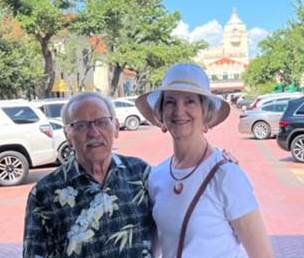

Rita and I of course have a personal interest. As residential condo owners overlooking the Plaza, we are excited about the upcoming restoration by the new owners (as outlined in this week’s press conference – click here).
Minute Maid Park in Houston, Texas: We flew from Dallas to Houston on Saturday evening and stayed in a hotel in the downtown area where Minute Maid Park is located.
Houston’s initial entry into the major leagues was as a National League expansion franchise in 1962. During the first three seasons, the team was known as the Colt .45s and played in Colt Stadium, a temporary structure used while the Astrodome was under construction. The first season in the Astrodome was in 1965, and the team was renamed the Astros.
The Astros played in the Astrodome until 1999, then moved to Enron Field where the team has played since the 2000 season. But with different stadium names. After Enron went bust in 2001, there was a several month period when the stadium was called Astros Field. In 2002, naming rights were sold to a Coca Cola subsidiary, and the stadium became known as Minute Made Park (a/k/a the “Juice Box”).
With the heat and humidity of Houston, air conditioning is a necessity. But instead of the fixed roof of the Astrodome, Minute Maid Park has a retractable roof.
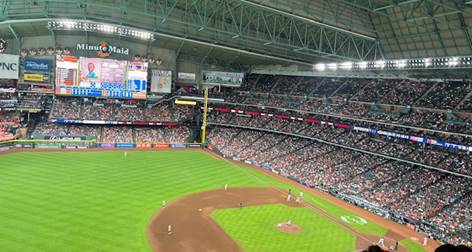
Our first stop at the stadium was the ticket booth. Where you can’t buy tickets. They can only help you do it online with your phone. The good news: The woman who helped us was terrific.
Minute Maid Park is familiar to most baseball fans via TV because the team has so often been in the postseason. Home runs hit to left field land in the Crawford Boxes. Just above those fans is a vintage train with a cargo of oranges (as in Minute Maid). The train runs back and forth at the beginning of the game, after wins and when the Astros hit a home run (which Jose Altuve did on the first pitch in the bottom of the first).

The 7th inning stretch is three-songs long – “God Bless America,” “Take Me Out to the Ballgame,” and “Deep in the Heart of Texas.”
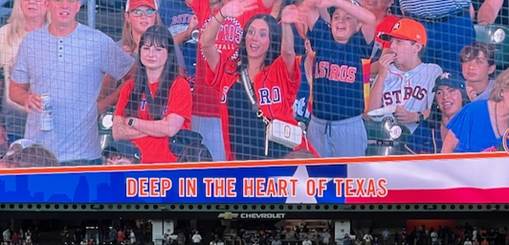
The Astros won the game, and I of course fret they will keep winning and knock the Royals out of the Wild Card slot. They have developed a near-dynasty in recent years. While in the National League from 1962 to 2012 (51 seasons), the Astros were in the postseason nine times and won one pennant. Since moving to the American League in 2013 (11 seasons), they have been in the postseason eight times, won four pennants and two World Series (in 2017 and 2022, as symbolized with replicas of the rings outside the stadium).
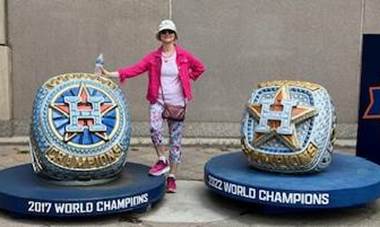
Yes, I am aware they cheated in winning the 2017 World Series.
Stadium Roofs: The two Texas stadiums provide fine fan experiences. The Rangers have some better amenities in their newer stadium, especially in the dining areas. But…
One overriding feature keeps any stadium off my top ten list. Retractable roof. Until last year, we had not been to a stadium where a retractable roof was closed. The first two such stadiums we attended had the roof open for the games (Toronto and Milwaukee). Last year, we attended a Diamondbacks game in Phoenix, and the roof was closed. No matter what fan amenities are provided, the first impression is that the game is being played in an airplane hangar.
One of the beauties of baseball is the open sky as an integral part of the stadium. My apologies to the roof cities, but I can’t help it.
It’s not their fault. In Toronto and Milwaukee, it’s the cold weather. For the two Texas stadiums and two Florida stadiums, it’s the heat, humidity and rain (Admission: It felt good to leave the heat and walk into the air-conditioned Texas stadiums). In the cold weather cities, the roof is often opened for games. In the hot weather cities, the roof is rarely opened.
We have not yet been to the two Florida stadiums, but I’m confident I’ll feel the same (especially for the Rays in St. Petersburg where the roof is fixed). When we get to Seattle, our experience may be better because the roof does not fully enclose the stadium. It’s more like a large metallic umbrella to be used on rainy days (time lapse video here).
Willie Mays Follow-Up: The last Hot Stove featured Willie Mays (RIP) and generated a couple of responses I want to pass along.
My son Brian sent me a video of Willie as a warlock on Bewitched. It’s charming (click here).
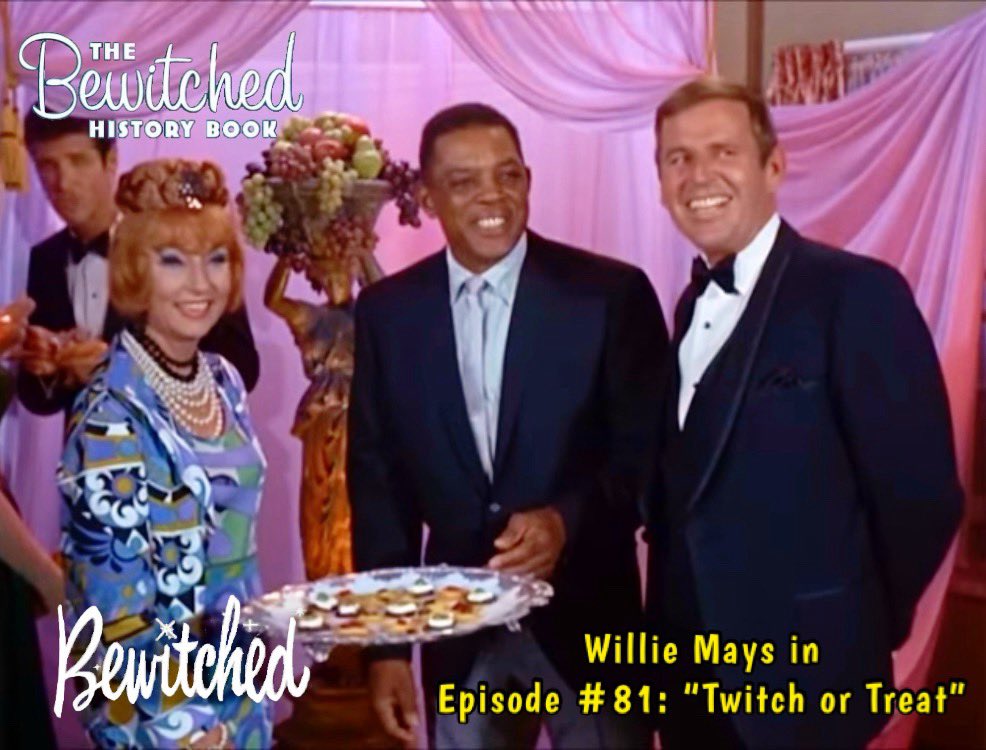
Bill Wakefield, former Pem-Day star athlete and MLB pitcher (NY Mets – 1964), sent friends an email about his connections with Willie. When Bill was 10 years old (1951), he was on his front porch in Kansas City and opened a baseball card bubble gum package. One of the cards was a Willie Mays. Bill still has the card.
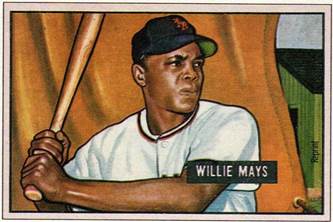
Thirteen years later, in May of 1964, Bill faced Willie in the first inning of what turned out to be a 23-inning game. Bill was gone after two innings, giving up two runs, one of them scoring on a single by Willie Mays. The game was the second of a doubleheader, and when it reached the 21st inning, it broke a record:
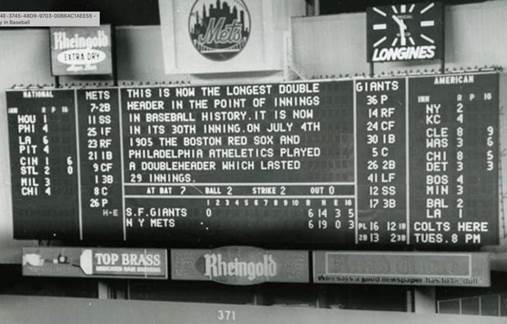
When the game finished in the 23rd inning, it established doubleheader records for innings (32) and time (9 hours, 52 minutes). Both are still records.
Bill colorfully tells of a second meeting with Mays: “1964 – August – Shea Stadium. I throw Willie good sinker (I thought) down and in (It WASN’T a low hard slider!!) – he hits it out off the scoreboard in right center…inside out swing. Loud. LOUD!! crowd cheer – Mets fans/Willie fans!!”
Bill had come on in relief in the 8th inning with the Mets behind 3-1. The ball hit by Mays was a homer because the scoreboard was 25-20 feet beyond the right field wall with a bullpen in between. As Bill says, “It was not cheap!!”
One of the recipients of Bill’s email was George Vecsey who covered the Mets as a NY sportswriter in 1964. George took Bill’s stories and turned them into a splendid blog post as a homage to Willie, “Willie Mays, Hero to Other Players.” Highly recommended (click here).
Orlando Cepeda (RIP): After Wakefield gave up the long home run to Willie, the next two batters he faced were also future Hall of Famers. Willie McCovey and Orlando Cepeda. He got them out. To paraphrase singer Meat Loaf, “Now don’t be sad, cause two (outs) out of three (Hall of Famers) ain’t bad.”

Orlando Cepeda died last week, just 10 days after Willie. His Hall of Fame career included being the unanimous selection as Rookie of the Year (as a Giant, 1958) and Most Valuable Player (as a Cardinal, 1967). He is one of five Giants honored with statues at Oracle Park (the others being Willie Mays, Willie McCovey, Juan Marichal and Gaylord Perry).
Of local Kansas City interest, Cepeda played his last season (1974) with the Kansas City Royals.

Cepeda was 86. RIP to the “Baby Bull” (a/k/a “Cha Cha”).
Lonnie’s Jukebox – Stax Records Edition: There is an excellent four-part HBO series currently streaming on MAX: Stax, Soulsville, U.S.A. (trailer here).
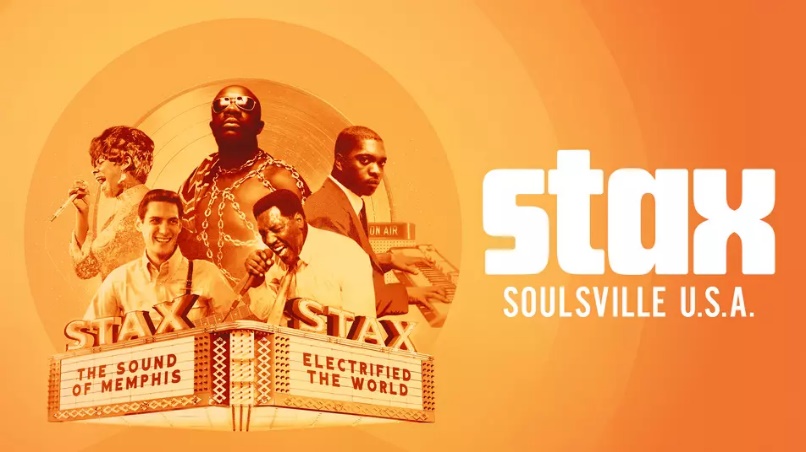
The famous Memphis recording studio opened in 1957 under the ownership of siblings Jim Stewart and Estelle Axton (the first two letters of their last names combining for Stax). The label featured a racially integrated team of staff and artists, not a normal scene in the South at the time. A good example was the integrated house band Booker T. & the M.G.’s who, working with a small group of songwriters, created the readily identifiable sound of Soulsville, U.S.A. Below, from left, Donald “Duck” Dunn (bass), Booker T. Jones (organ, piano), Steve Cropper (guitar) and Al Jackson Jr. (drums).
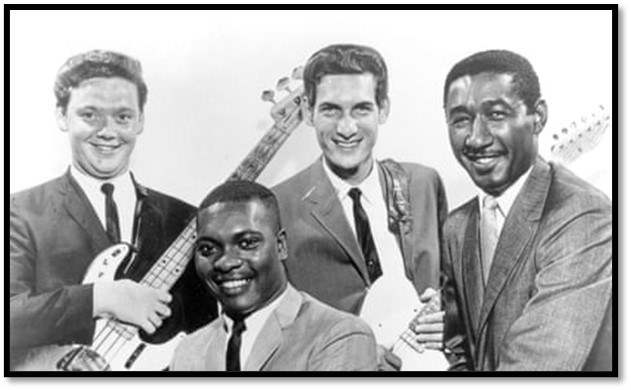
Some of the many hits from Stax…
“Last Night” by the Mar-Kays (1961). The title track on Last Night, the first LP released by Stax.
“Gee Whiz (Look at His Eyes)” by Carla Thomas (1961). Written by Carla Thomas when she was 16.
“Green Onions” by Booker T. & the M.G.’s (1962). The signature song of the band playing behind most of the hits at Stax and its sister label Volt.
“Walking the Dog” by Rufus Thomas (1965). Patriarch of talented music family in Memphis, including daughter Carla Thomas.
“In the Midnight Hour” by Wilson Pickett (1965). Released on Atlantic Records, but recorded at Stax, and co-written with Steve Cropper and featuring other band members from the M.G.’s.
“Knock on Wood” by Eddie Floyd (1966). Co-written by Floyd with Steve Cropper.
“Soul Man” by Sam and Dave (1967). The singers are Samuel “Sam” Moore and David “Dave” Prater. The songwriters are Isaac Hayes and David Porte whose intent was to reflect pride in African Americans after the devastating Detroit riots.
“Who’s Making Love” by Johnnie Taylor (1968). A #1 on the R&B chart and #5 pop. In addition to Booker T. & the M.G.’s, the record featured Isaac Hayes on keyboards.
“(Sittin’ On) The Dock of the Bay” by Otis Redding (1968). The year 1967 had been big for Otis Redding. As a songwriter, his “Respect” was covered by Aretha Franklin and went to #1. He wowed the crowd at the Monterey Film Festival. In the fall, he worked on a song with Steve Cropper and recorded some tracks. Redding then went on tour, and on December 10, he died in a plane crash. Stax quickly produced a record from the recorded tracks and released “(Sittin’ On) The Dock of the Bay” on January 8, 1968. It was #1 for four weeks, his only #1 hit. Redding became the first artist in chart history to have a posthumous #1 (sadly followed by Janis Joplin in 1971 with “Me and My Bobby McGee” and Jim Croce in 1972 with “Time in a Bottle.”
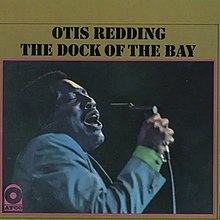
“Theme from Shaft” by Isaac Hayes (1971). A #1 hit and winner of the Academy Award for Best Original Song.
“Mr. Big Stuff” by Jean Knight (1971). A #2 hit.
“I’ll Take You There” by the Staple Singers (1972). A #1 hit.
To close, the Stax logo, representing their “finger snapping” music. Amen.
